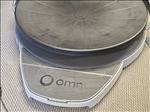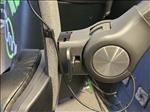
Virtuix Omni One
Virtuix has been in the VR treadmill game for over 10 years starting with their Kickstarter back in 2013. I was one who got in as an Early Bird backer and received one of the original Virtuix Omnis many years ago.
They were kind enough to invite me out to their office in Austin, Texas to check out their latest product, the Omni One. Virtuix is hoping this is the product that appeals to VR enthusiasts and becomes what their first Omni wasn’t capable of. The previous offering was a solid version 1 of a VR treadmill, but suffered from software support or lack thereof. With Virtuix’s recent announcement of over 30 third party games putting Omni One support in there, this might be what it needs to meet Virtuix’s goal of being a mainstream product.
But before I got to try out the Omni One, I was treated to a tour of their office. From the outside, there’s not much to signify that the building houses a large collection of Omni products. As you walk in, you’re treated to two Omni One displays front and center.

Just behind them is an Omni Arena setup. If you haven’t seen one of those, they are commercial setups where people can try out an original Omni with up to three other people in a fun multiplayer setting. There’s one setup by me in a bowling alley and it’s a pretty impressive sight. I hopped into a zombie shooting game with two other employees of Virtuix using an HTC Vive Pro and the good ole wand controllers. It was great fun running around with two other people taking out the undead using different weapons, both melee and guns, in a controlled environment where all you had to do was put on the shoes, strap yourself into the ring, and just run around literally causing mayhem. I know it takes me a lot of tinkering back in the day to get it to work with a game, but these Omni Arena setups are great for those who are curious to try one out as well as those who don’t want to do all the work to get one up and running.

Now the Omni One is billed as an all in one solution that’s super simple to get into and get going. What I was treated to is considered a beta and things are subject to change. But, As you can see, there’s no longer a safety ring, but you’re strapped into a backpack-like harness that keeps you from falling over. Let me tell you it feels way different than being in an original Omni as you feel much freer without a belt and in my case, an old harness with straps around my legs. Going from a very secure feeling of the original Omni where the safety ring made you felt like you had limited movement vertically to just a vest setup that allowed you to jump and crouch was a big difference and one that had me apprehensive in going full bore on the Omni One a few times.

Getting into the Omni One was a simple process. The ring’s locked in place so you can strap yourself into the vest pretty easily. I did feel I had to be more careful where I step because on the original one, you had the big ring that’s near your waist to hold onto to keep you from falling. For the Omni One, I made sure to hold on to the vest arm so I wouldn’t fall getting myself into it.
Strapping yourself in is also a lot quicker than before as it’s more like putting on a backpack and then buckling the waist and chest belt. Once in, you push a button and then the ring where the arm’s attach unlocks and you’re good to move around in place.
Because this is an all in one solution, I was given a Pico headset that comes with the Omni One. Virtuix has built a software setup and UI that makes it easy to fire up a game and go. And that’s a big thing with the Omni One. With their announcement of over 30 games that will have Omni One support, you’ll have titles that are ready to go out of the box to work with the Omni One, unlike the original Virtuix Omni.

I’ve never used a Pico headset before, but it felt like the Quest 3 to me with its pancake lenses and ease of use in putting it on and having a large sweet spot. I’m not going to comment on the headset quality as I didn't have enough time to do a deep dive with it but it had very little screen door effect and solid picture during my testing session. The controls seem to be similar to the Quest 2 with a tracking ring around the grip. If you’ve used the controls of a Quest 2, then the Pico’s controls are pretty similar.
I fired up another zombie shooter and proceeded to run around the rooms shooting spawning zombies and running to a new zone when the time was up. It took a bit of time to get used to running in the Omni One, even with my experience with the original Omni. As with the original, you put a foot forward and glide back to move. It takes a bit to get used to, but your body will begin to get used to the motion and you’ll feel more comfortable as time goes on. The big thing is putting trust into the arm and vest to keep you from falling. It’s a sensation that’s odd at first, but like the change in movement, you’ll get more comfortable the longer you do it. For me, that was the biggest hurdle of this one as you feel a lot less restrained in the Omni One and it does take time to trust the mechanism holding you in.
Because there’s no ring around you, the freedom of movement is increased. Your arms aren’t going to be hitting anything as you swing them around to aim or slice a zombie with a sword. That’s big and helps increase the immersion level and lets you be more animated with your arm movements without fear of hitting it on something. I had no issues making more exaggerated swings with my arms when I had a melee weapon in order to take big slices at the incoming horde.

Ducking and jumping? No problem here. I didn’t do as much of that as I was too busy trying to run around from the zombie horde, but getting down to one knee to crouch was simple and unhindered. I didn’t try a game where I had to jump, but Jan Goetgeluk showed off how you can jump in the Omni One and still be safely held in place.
One of the things the Omni One does let me do and I found myself naturally doing is running one way and looking at another way while aiming someplace else. In FPS games, I do a lot of side to side strafing. In the Omni One, I found myself running in circles around a horde of zombies while looking at them with my head turned to the side. I would find myself aiming my gun initially where I was looking at and as I was running past where I was looking, my one arm would follow them to continue to shoot at them to a point where it was almost behind me. And since I was dual wielding, my other arm would sometimes aim in a completely different area that I would not even be watching but glanced at to see if a horde was coming. The feeling of freely moving in one direction, looking at another, and aiming anywhere is truly astounding.
I did try a few things like backing up and side strafing. It’s still a little awkward to side strafe by trying to move one leg out, so I found the running in circle technique to be a lot more effective and natural. Backing up also seemed a little awkward at first because you feel like you’re backing into an immovable wall. I tried it a few times, but I quickly abandoned this technique. I think if I had more time to experiment, I would be able to comfortably back up by running backwards.
Quickly turning can also make it feel like you’re fighting the Omni One ring for a little bit. The Omni One ring circles the base as you are turning around, keeping the backpack attachment squarely behind you. There were a few times I tried to quickly turn right while running and quickly turn left. I felt the ring resist me a little before turning the other direction. Again, with more time in the Omni One, I feel like I can adapt to this, but it is something I was aware of in my testing session.

Let’s talk a little bit about the construction. It’s certainly a lot less imposing than the original Omni as now there’s basically one arm, a vest, and a base. The arm felt very solid and I never really felt it when I was using the Omni One. It’s easily height adjustable with markers on the side to let you know how high it is and changing the height of the vest was pretty easy, quick, and straight forward. The base is now completely round instead of an octagon and there’s still the lip in the front where you can safely step on and off of. The rotating ring seems to also be very strong and I was surprised at how quiet it was when it rotated around the base. You could barely hear it.
Moving the Omni One is a lot easier thanks to the included wheels underneath. You can pick one side up and roll it around. I shudder to think how I am going to move the original Omni in my basement as that thing’s a beast in terms of weight and lack of wheels.
The entire setup will support players as short as 4’4” and to as tall as 6’4” with a weight limit of 250lbs. That seems to support a wide range of body types and like I said earlier, adjusting the height was super simple and quickly done by moving the arm up and down and locking it in place.
While my home setup uses full shoes, the Omni One uses slip ons that go over your shoes and that has the material underneath that lowers the friction between your feet and the bowl in order for the setup to work.It’s the same slip ons that you see if you go to an Omni Arena experience.

The Omni One is made to be completely stand alone and easy to use. That’s why Virtuix includes a headset with custom software so you aren’t messing with any configurations. They want you to easily get in it and go. Reducing the effort in using something like an Omni One is important because I know there were plenty of times I just decided not to get into mine or use VR because of the amount of time and effort needed to get it setup. From my brief experience, it seemed really easy and quick to get in and out of it.
But, what if you want to use it with something else. While there aren’t currently plans to support other stand alone headsets yet, Virtuix is supporting connecting the Omni One to a PC. I do wish we would see some high profile VR PC games get native Omni One support, but until then you will have the ability to mimic a joystick or a keyboard with the Omni One and use it with some of your favorite VR games. It might not be the seamless experience that the Pico headset offers with their custom software and native game support, but it’s an option for PC gamers and hopefully we can see some good mods come out when more Omni Ones are in consumer hands.

The Omni One does keep track of statistics like how much you’ve used it and the distance traveled. I asked the Virtuix team about perhaps exposing some of that information through an API so developers can tap into the information and perhaps record it in their favorite exercise app. They seem open to that idea, so let’s hope that’s in the cards for the future.
Now, the price is going to be what’s going to give a lot of people pause when considering the Omni One. It’s $2,595 and that’s not including shipping, which is estimated to be in the $200 to $300 range. So you’re talking close to $3000 when it’s all said and done to have this setup in your house. Virtuix does intend to offer a monthly payment plan to help soften that large upfront cost, but $2,595 plus shipping is pretty expensive. The Omni One is starting out in a better state than the original with a lot of games support right out of the box, so hopefully this will get more buy in which in turn will turn into more support by game developers.
I had a great time testing the Omni One and I want to thank the people at Virtuix for making it happen. You can pre-order this now for an estimated Q4 2024 release.

* The product in this article was sent to us by the developer/company.

About Author
I've been reviewing products since 1997 and started out at Gaming Nexus. As one of the original writers, I was tapped to do action games and hardware. Nowadays, I work with a great group of folks on here to bring to you news and reviews on all things PC and consoles.
As for what I enjoy, I love action and survival games. I'm more of a PC gamer now than I used to be, but still enjoy the occasional console fair. Lately, I've been really playing a ton of retro games after building an arcade cabinet for myself and the kids. There's some old games I love to revisit and the cabinet really does a great job at bringing back that nostalgic feeling of going to the arcade.
View Profile












